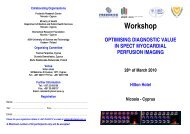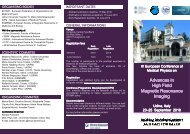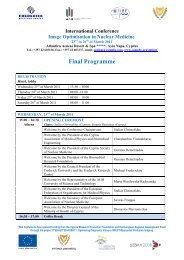medical physics international - Cyprus Association of Medical ...
medical physics international - Cyprus Association of Medical ...
medical physics international - Cyprus Association of Medical ...
- No tags were found...
Create successful ePaper yourself
Turn your PDF publications into a flip-book with our unique Google optimized e-Paper software.
MEDICAL PHYSICS INTERNATIONAL Journal, vol.1, No.1, 2013EFFECTIVE PHYSICS EDUCATION FOR OPTIMIZING CT IMAGEQUALITY AND DOSE MANAGEMENT WITH OPEN ACCESS RESOURCESP. Sprawls 1 , P-A. T. Duong 21 Sprawls Educational Foundation and Emory University/Department <strong>of</strong> Radiology and Imaging Sciences, Montreat, USA2 Emory University/Department <strong>of</strong> Radiology and Imaging Sciences, Atlanta, USAAbstract: The most effective optimization <strong>of</strong> CT imagequality and related radiation dose management requires aclinical imaging staff with knowledge <strong>of</strong> the <strong>physics</strong>principles that apply to the imaging process. This knowledgecan be developed through a combination <strong>of</strong> learningactivities, including classroom discussions, but a criticalrequirement is guided learning activities associated with theclinical imaging procedures. A program is described forincluding <strong>physics</strong> education within clinical activities,especially for trainees, and online open access resources areprovided to enhance the process.Keywords: Computed Tomography, PhysicsEducation, Image Quality, Radiation Dose Management.INTRODUCTIONComputed tomography (CT) is now one <strong>of</strong> the mosteffective and valuable imaging methods for <strong>medical</strong>diagnosis and guiding therapeutic procedures. With thecontinuing advances in technology there is the capabilityto produce images with characteristics that can beoptimized for a wide range <strong>of</strong> clinical purposes. Also,there is the need to manage the radiation dose for eachpatient and balance it with respect to the image qualityrequirements. This is achieved by adjusting the protocolfactors for each procedure. Developing an optimizedprotocol requires knowledge <strong>of</strong> the clinical requirements,the design and functional characteristics <strong>of</strong> theequipment, and especially the physical principles and<strong>physics</strong> that is the foundation <strong>of</strong> the CT imaging process.There is a significant challenge in providing the <strong>medical</strong>pr<strong>of</strong>essionals who have responsibility for and whoconduct CT procedures with the appropriate knowledge<strong>of</strong> <strong>physics</strong> that can be applied to enhance theeffectiveness and safety <strong>of</strong> CT. A model <strong>of</strong> acollaborative approach to providing this education, on aglobal basis, is described along with the online resourcesthat are open access and can be used in any CT program.Figure 1. The model <strong>of</strong> a program to provide <strong>physics</strong> educationto support clinical CT procedures.CONTROLLING THE CT PROCEDUREThere are two major factors that can be controlled ineach CT procedure as illustrated in Figure 1. One is thecharacteristics and quality <strong>of</strong> the image and the other isthe radiation dose delivered to the patient. The directcontrol <strong>of</strong> these by the <strong>medical</strong> staff is through theadjustment <strong>of</strong> the imaging protocol which is the complexcombination <strong>of</strong> quite a few individual protocol factors.A. Technology. The imaging capabilities and ability tomanage radiation dose that are available in a specificclinic depend on the design characteristics <strong>of</strong> the CTequipment. With the continuing development andinnovations there is generally the opportunity to producehigher quality images and to do it with a reducedradiation dose to the patient. However, this can only beachieved if the staff is capable <strong>of</strong> developing and usingprotocols that are optimized for each.B. Science. Physics is the fundamental science <strong>of</strong>CT. The imaging process and the design <strong>of</strong> thetechnology are based on <strong>physics</strong> principles. That is theknowledge used by physicists and engineers in the46






